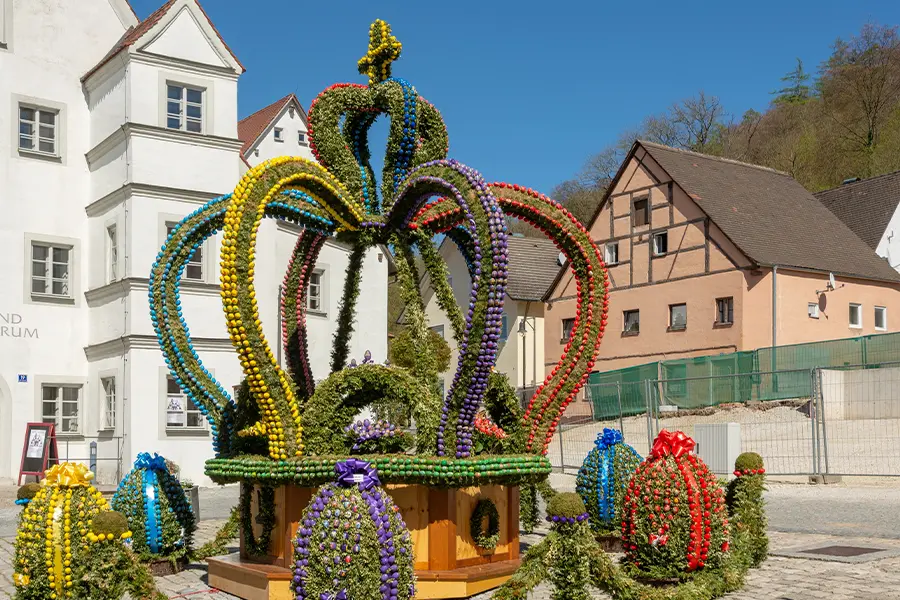- Home
- German Holidays and Customs
- Easter Egg Traditions
Easter in Germany: Where Eggs Are Too Pretty to Eat (But We Eat Them Anyway)
By: Eran Fulson / Traveler & Blogger / After 15+ years of travel across North America and Europe, I now help travelers experience Germany beyond the guidebooks with firsthand tips and cultural insights.
Published: February 26, 2025
Ah, Easter in Germany—a time when people take something as ordinary as an egg and turn it into a painstaking work of art, all before cracking it open for a celebratory omelet. The traditions surrounding Easter eggs in Germany are as intricate as the designs themselves, blending history, religion, and a surprising amount of patience. Let’s crack this open and see what’s inside.

A Brief History: From Pagan Rituals to Christian Symbolism
Long before chocolate bunnies took over store shelves, eggs were already a big deal. Ancient civilizations—Egyptians, Persians, and pretty much anyone looking for an excuse to celebrate spring—exchanged decorated eggs as symbols of life and rebirth. Then Christianity arrived and repurposed them to represent the resurrection of Jesus Christ.
Practicality also played a role: medieval Europeans, forbidden from eating eggs during Lent, ended up with a surplus. Instead of letting them go to waste, they boiled, decorated, and eventually devoured them in celebration of Easter.
That’s right—one of history’s most enduring traditions began with people finding ways not to waste food. Very on-brand for Germany.
Sorbian Eggs: When Decoration Becomes a Masterpiece
In eastern Germany, particularly in the historic region of Lusatia, the Sorbian community turned egg decorating into an extreme sport. Their traditional methods include:
- Wax-Resist (Batik): Melt wax, paint patterns, dye the egg, and then remove the wax to reveal an intricate design. Precision required; coffee-fueled nerves recommended.
- Scratch Technique: Dye first, then scratch delicate patterns onto the shell. A good method for those with an artistic flair—and an iron grip.
- Etching: Apply acid to the dyed egg, revealing lace-like patterns. A chemical reaction has never looked so elegant.
- Wax Embossing: Layer colored wax to create a textured, multi-dimensional masterpiece. Imagine decorating an egg with tiny sculptures—because why not?
These techniques demand patience, skill, and the willingness to spend hours on something that could break if you sneeze too hard.
Sorbian Eggs Gallery:
Osterbrunnen: When Decorating Eggs Isn’t Enough
Franconia took things one step further. Instead of limiting themselves to eggs, they decided that entire public fountains needed a festive makeover. Enter the Osterbrunnen, or Easter fountains—elaborately decorated wells adorned with garlands, flowers, and hundreds of painted eggs.
The tradition started in the early 20th century as a way to honor water as a life-giving force. Today, towns like Kipfenberg go all out, turning their fountains into colorful, egg-covered tourist attractions.
Because if you’re going to celebrate Easter, you might as well do it with thousands of fragile, hand-painted eggs in a public space.
The Ostereierbaum: Germany’s Answer to its Own Christmas Tree
If there’s one thing Germans love, it’s an excuse to hang things on trees. Enter the Ostereierbaum, or Easter egg tree, a tradition that involves decorating branches with painted eggs—because apparently, Christmas trees weren’t enough work.
This egg-hanging obsession has been around for centuries, rooted in the broader European practice of celebrating spring by making nature look festive. Eggs, being symbols of renewal and fertility, were the obvious choice.
But in true German fashion, some people took it to the extreme. The Kraft family of Saalfeld, for example, decided that hanging a few eggs on a tree wasn’t ambitious enough. Instead, they spent decades adding more and more until their apple tree boasted over 10,000 eggs.
If you’re wondering when they stopped, the answer is 2015—because even the most dedicated holiday decorators have limits.
Is the Ostereierbaum Still Popular?
Today, the Ostereierbaum takes many forms. Some people stick to dainty indoor displays with a few carefully arranged branches in a vase, while others go all out with towering outdoor trees covered in hundreds (or thousands) of eggs.
Social media has only fueled the competitive spirit, with DIYers one-upping each other with increasingly elaborate, color-coordinated displays. Some go for classic hand-painted eggs, others prefer the shiny plastic variety, and a few opt for eco-friendly wooden or ceramic versions so they can reuse them next year.
Because nothing says 'Easter spirit' quite like a tree covered in eggs and the existential dread of packing it all away when the holiday is over.
Modern Egg Decorating: Keeping the Tradition Alive
Germans haven’t let these traditions fade. Workshops still teach Sorbian techniques, Easter markets sell hand-painted eggs, and plenty of people still decorate their own. Whether you’re aiming for a historically accurate wax-resist masterpiece or just trying to make sure your toddler doesn’t eat the paint, there’s a technique for everyone.
DIY Guide: How to Decorate Eggs Like a Pro (or at Least Like Someone Who Tried)
- Choose Your Canvas: Chicken eggs are classic, but goose and duck eggs offer a larger, more forgiving surface (because, let’s be real, mistakes will happen). Empty or hard-boil them first—unless you enjoy high-stakes decorating.
- Wax-Resist Method: Draw patterns with melted wax, dye the egg, then scrape the wax off to reveal the design. Warning: May induce perfectionism.
- Scratch Method: Dye the egg, then carve out your design. Like wood carving, but with added anxiety.
- Natural Dyes: Use onion skins for rich browns, red cabbage for blues, and beetroot for pinks. Bonus: It’s eco-friendly and makes you feel like an alchemist.
- Modern Options: If precision art isn’t your thing, grab some acrylic paint, permanent markers, or washi tape. No judgment.
- Show It Off: Hang them on an Ostereierbaum (Easter egg tree), arrange them in a decorative bowl, or hide them around your house for the ultimate test of memory six months later.
If you've never hardboiled eggs before, check out Oma's easy method for either stovetop or in the oven. And if you've already dropped one (or two), I've also added Oma's recipe for scrambled eggs and ham.
Family-Friendly Egg Decorating (For Those Who Prefer Fun Over Perfection)
Not everyone has the patience of a Sorbian artisan. If you're decorating eggs with kids, or just want something less stress-inducing, here are some fun alternatives:
- Acrylic Paint: Bright, bold, and dries fast. Also, very forgiving if your design starts looking like an abstract art piece.
- Markers: Ideal for lazy decorators or people who just want to doodle on an egg.
- Stickers: Slap some on and call it a day. No mess, no stress.
- Washi Tape: Great for geometric designs and for people who appreciate minimal effort.
- Melted Crayon: Color on warm eggs, and watch the wax melt into cool designs. Surprisingly satisfying.
- Decoupage: Cut out patterns from napkins, glue them on, and suddenly, you look like you know what you're doing.
Easter Egg Inspiration:
Final Thoughts: Join the Tradition (Or Just Appreciate It From Afar)
German Easter egg traditions prove that humans will go to great lengths to make something as mundane as an egg look spectacular. Whether you're admiring a Sorbian masterpiece, gawking at an over-the-top Osterbrunnen, or just sticking googly eyes on an egg, there's a way for everyone to participate.
So this Easter, grab an egg (or a dozen), get decorating, and maybe—just maybe—don’t drop them on the floor.



























